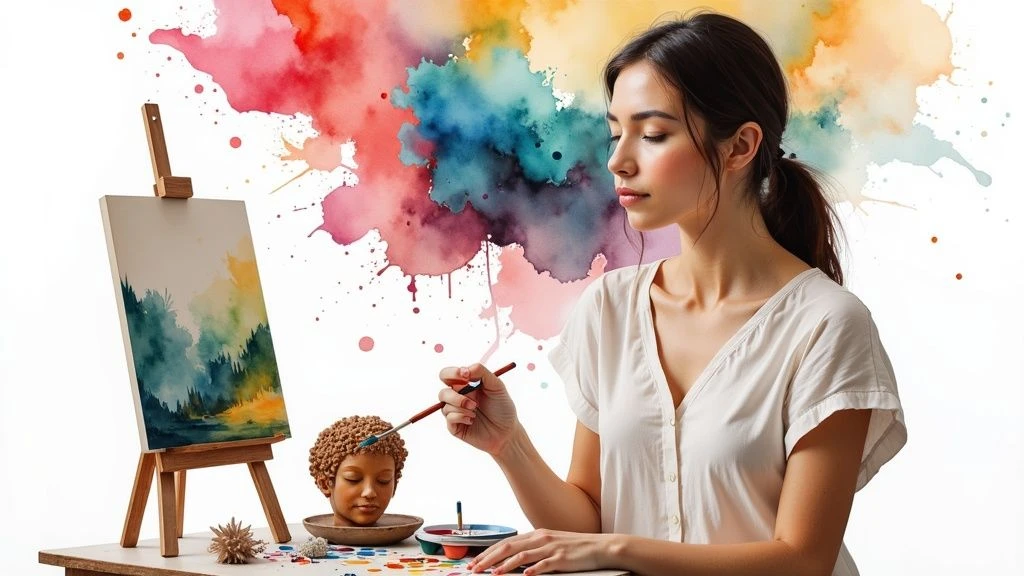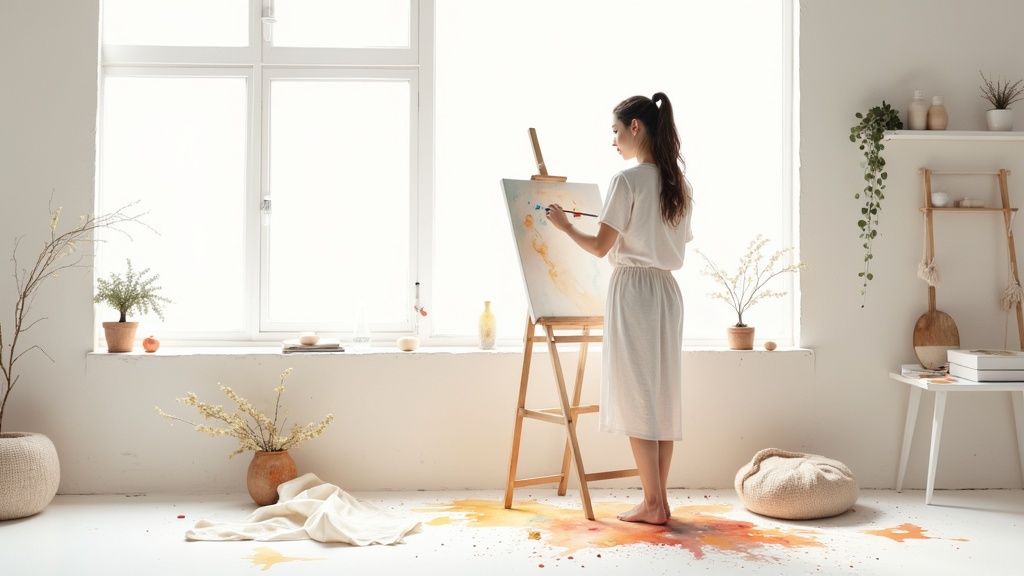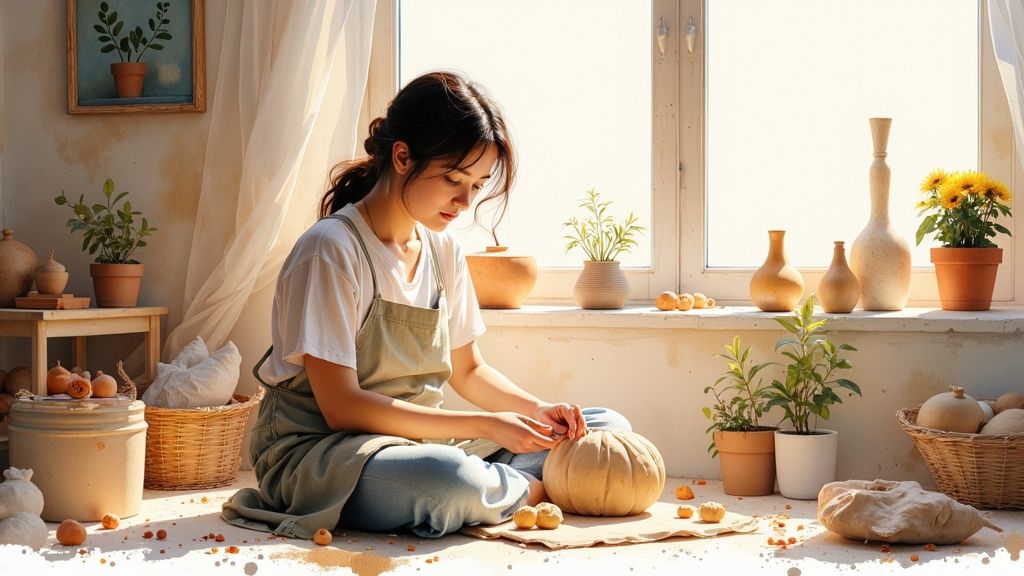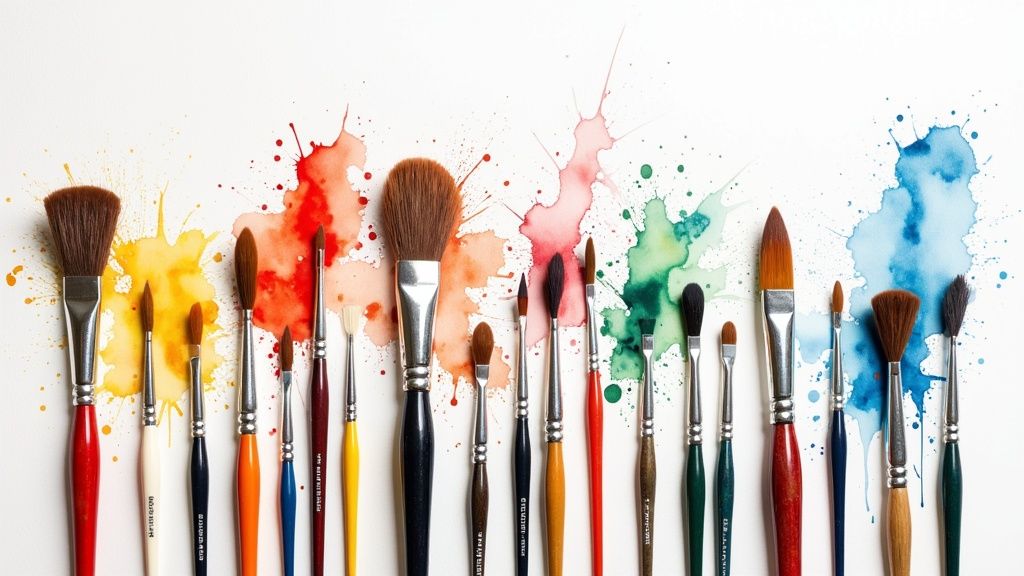10 Proven Art Therapy Activities for Anxiety: A Comprehensive Guide to Creative Healing
January 31, 2025

Understanding the Science Behind Art Therapy and Anxiety

When you make art, you're doing much more than just creating something beautiful - you're engaging in a process that can help calm your mind and ease anxiety. The connection between art-making and anxiety relief isn't just anecdotal - there's real science behind why picking up a paintbrush or molding clay can help you feel more centered and relaxed.
The Neurological Impact of Art on Anxiety
Making art affects your brain in powerful ways. When you create something, your brain releases dopamine - a feel-good chemical that can lift your mood and counter anxious feelings. As you focus on your artwork, you also activate your brain's prefrontal cortex, which helps with planning and decision-making. For someone dealing with anxiety, this focused attention can provide a much-needed break from worried thoughts and help restore a sense of control.
How Art Therapy Rewires Neural Pathways
Your brain's amygdala plays a big role in processing fear and anxiety. Art therapy can help reshape how this emotional control center responds to stress. Think of it like creating a new path through a forest - the more you practice art therapy, the more established this calmer route becomes, making it easier for your brain to stay peaceful even when facing anxiety triggers.
The Power of Non-Verbal Expression
Sometimes words just aren't enough to express how anxiety feels. That's where art therapy shines - it gives you a way to share complex emotions without having to find the right words. A splash of dark color or a jagged line might say more about your anxiety than a thousand words could. The numbers back this up too - research shows that 71% of people feel less anxious after trying creative arts therapy. You can learn more about these findings here: The Compelling Impact of Art Therapy: 6 Eye-Opening Statistics.
Different Approaches, Varied Benefits
Not all art therapy activities work the same way. Drawing mandalas, for example, can help quiet a racing mind through its repetitive patterns. Other people might find relief in painting emotional landscapes that help them spot anxiety triggers and plan how to handle them. The key is finding what works best for you - whether that's sketching, sculpting, or any other creative activity that helps you feel more grounded.
Creating Your Therapeutic Art Space: Essential Setup and Materials

Setting up a dedicated space for art therapy is like creating a cozy reading nook – it needs to feel safe and inviting. Whether you have a full room or just a quiet corner, this personal creative sanctuary becomes a place where you can freely express emotions through art. The right environment helps you feel grounded and ready to explore your feelings.
Designing Your Space for Maximum Benefit
Think of your art therapy space like a peaceful garden that needs the right conditions to flourish. Start by clearing away clutter and distractions that might interrupt your creative flow. Good lighting, comfortable seating, and calming elements help create an atmosphere where you can focus on self-expression and healing.
- Remove distractions: Keep phones out of sight, silence notifications, and let others know you need quiet time
- Pick comfy seating: Find a chair that keeps you comfortable but alert - add a cushion if needed
- Add soothing touches: Soft lighting, gentle scents like lavender, or quiet nature sounds can help you relax
Essential Art Therapy Materials for Anxiety Relief
Just like a chef needs the right ingredients, your art therapy practice needs the proper tools. Having different materials lets you experiment and find what works best for expressing your emotions. Some people find peace in detailed coloring, while others prefer the freedom of painting or sculpting. You might want to check out our complete guide to the best adult coloring books for creative relaxation.
- Paper and drawing tools: Keep various papers (sketch, watercolor, construction) and drawing implements (pencils, markers, crayons) within reach
- Painting supplies: Try watercolors, acrylics, or gouache to explore different ways of expressing yourself
- Clay: Working with clay can help ground you in the present moment through touch
- Extra materials: Consider adding magazines for collage, natural items like leaves, or recycled materials to mix things up
Organizing Your Supplies
Good organization makes it easy to start creating whenever inspiration strikes. When your art supplies are neatly arranged and easy to find, you're more likely to use them regularly. Think of it like keeping your kitchen organized - you're more likely to cook when you know where everything is.
- Smart storage: Use drawers, shelves, or bins to sort materials by type
- Clear labeling: See-through containers or labels help you grab what you need quickly
- Portable options: Pack a small art kit for creative sessions away from home
Five Art Therapy Exercises for Beginners

Once you've set up your creative space and gathered basic art supplies, you're ready to explore some simple but effective art therapy activities. These exercises are perfect for anyone new to art therapy - no artistic experience needed. Each activity offers a different way to express and process anxiety through creativity.
Emotional Landscape Mapping
Think of this exercise as creating a map of your feelings. Pick up some paints, markers, or crayons and let your emotions guide your hand across the paper. You might draw sharp, zigzag lines to show racing thoughts, or use deep blues and purples for heavy feelings. By putting your anxiety on paper, you can start to see patterns and make sense of what you're experiencing.
Anxiety Color Wheel
Draw a circle and divide it into sections - like slicing a pie. Label each slice with different feelings tied to your anxiety, such as worry, fear, or restlessness. Choose colors that match how intense each emotion feels to you. Looking at your completed wheel can help you spot which emotions show up most often when anxiety strikes.
Therapeutic Mark-Making
Sometimes the simplest actions can bring the most relief. Grab a pencil, piece of charcoal, or dip your fingers in paint and just make marks on paper. Try different pressures, speeds, and patterns. Pay attention to how your body feels as you make each mark - you might be surprised how this basic movement can help release built-up tension.
Mindful Mandala Creation
Creating circular patterns called mandalas can quiet an anxious mind. As you draw or color these intricate designs, focus on the rhythm of your movements and the colors you choose. Research shows this type of creative activity really works - a study of 200 people found that just 45 minutes of making art lowered stress levels significantly. You can learn more about art's calming effects in this article about therapeutic benefits of art for anxiety management.
Expressive Writing Through Art
Mix drawing with writing to dig deeper into your anxiety. Start by creating an image that represents how you're feeling. Then write about what the image means to you and what emotions come up as you look at it. This combination of visual art and words can help you understand your anxiety better and spot patterns you might have missed before.
For more creative inspiration, check out this guide to adult coloring.
Advanced Therapeutic Techniques: Mastering Clay and Paint

After exploring basic art therapy activities, let's dive into the hands-on world of clay and paint. These materials offer unique ways to express and work through anxiety. Whether you're squishing clay between your fingers or watching paint flow across a canvas, these techniques help you connect with and release difficult emotions.
Therapeutic Clay Manipulation
There's something deeply calming about working with clay. Its soft, moldable texture invites you to physically work out tension and anxiety through your hands. Many people find that simply handling clay helps their racing thoughts slow down.
Here's how to get the most out of clay work:
- Kneading and Shaping: Start by simply squeezing and kneading the clay. Notice how the repetitive motion helps release muscle tension. Let your hands work out the stress as you shape the clay into balls, coils, or whatever form feels right.
- Sculptural Expression: Create shapes that represent your feelings - maybe a tight ball for contained anxiety or spreading tendrils for scattered thoughts. There's no need to make anything "perfect" - the process matters more than the end result.
- Texture Play: Press patterns into the clay with your fingers or tools. Make smooth areas and rough spots. These textures can mirror your emotional state and help you understand your anxiety in a new way.
Expressive Paint Application
Paint offers a different kind of emotional release through color and movement. The way paint moves and blends can mirror how anxiety ebbs and flows in your body and mind.
Try these painting approaches:
- Color Exploration: Pick colors that match your mood - maybe bold reds and oranges for anxious energy, or cool blues and greens for calm. Mix colors and see how they interact, just like your different emotions mix and shift.
- Brush Movement: Experiment with different strokes. Quick, short marks might express nervous energy, while long, flowing strokes could help you find a sense of peace. Let your hand move naturally with the brush.
- Building Layers: Start with light washes of color and gradually add more. Each layer can represent a different aspect of your anxiety. Watch how the layers interact and create something new - just like how working through anxiety creates new understanding.
Combining Media for Maximum Impact
Some of the best breakthroughs happen when you mix materials. Try making a clay sculpture and painting it, or press clay textures into wet paint. This combination of tactile and visual expression often leads to deeper insights about anxiety.
Research backs up these approaches. A recent study with college students showed that art-making significantly reduced anxiety levels. The most effective technique turned out to be working with clay, especially when students could really get physical with the material. You can read more details in this study: The Effectiveness of Art Therapy for University Students.
Looking for more creative ways to manage anxiety? Check out How to Master Advanced Coloring Pages for another helpful approach.
Building a Sustainable Art Therapy Practice
Making art therapy a consistent part of your life can help manage anxiety much more effectively than occasional creative sessions. Just like regular exercise builds physical strength, frequent art therapy builds emotional resilience and coping skills that serve you day after day.
Establishing a Routine That Works for You
The key is starting with a manageable routine that fits naturally into your life. Instead of setting unrealistic goals, begin with just 15-20 minutes of creative time. Pick a time when you typically feel most energetic and focused, then protect that slot like you would any important meeting or appointment. Small, steady steps help form lasting habits.
Overcoming Barriers to Consistency
Even with the best intentions, life can disrupt our plans. The trick is preparing for common obstacles before they arise. If time is tight, keep a small sketchbook and few art supplies in your bag for quick creative breaks. When motivation dips, look back at your journal entries about past sessions to remind yourself how art therapy helps you feel better.
Maintaining Momentum Through Creative Blocks
Getting stuck creatively is perfectly normal and doesn't mean you're doing anything wrong. Instead of giving up, use blocks as chances to try something new. Pull out different materials, revisit a past exercise with fresh eyes, or just let yourself doodle freely without judgment. Remember, the goal isn't creating gallery-worthy art - it's connecting with yourself and easing anxiety. Research shows art therapy's effectiveness, with 78% of people experiencing mental health improvements. Learn more in this article: The Transformative Power of Art Therapy.
Adapting Your Practice to Changing Needs
Your art therapy practice should shift along with your emotional state. Notice how you're feeling and adjust accordingly. During high-stress times, try soothing activities like drawing mandalas. When you're feeling steadier, experiment with freer forms of expression like intuitive painting. Being flexible helps keep your practice relevant and helpful.
Tracking Progress and Celebrating Success
Keeping a simple journal of your art therapy journey lets you see how far you've come. Note what you did in each session, how you felt, and any insights that came up. This record helps you spot patterns and triggers over time. Take time to celebrate small wins too - completing a session, trying something new, or simply showing up for yourself. Building connections with others who practice art therapy, whether online or in person, provides extra support and encouragement for staying consistent.
Overcoming Common Challenges and Expert Solutions
Starting art therapy has its ups and downs. While the process can bring relief from anxiety, you might face some bumps along the way. Let's look at common challenges and practical solutions to help you build a lasting art therapy practice.
Perfectionism and the Fear of "Not Being Good Enough"
Many people struggle with perfectionism when starting art therapy. You might worry that your art isn't "good enough" or feel embarrassed about your skill level. Remember - art therapy isn't about creating gallery-worthy pieces. Think of it like keeping a visual diary - the goal is expressing your feelings, not impressing others. Give yourself permission to make "bad" art and focus on how creating makes you feel rather than how the final piece looks.
Overcoming Creative Blocks
Getting stuck is a normal part of any creative process. When you hit a creative block, try switching things up. Put down the paintbrush and pick up some modeling clay. Move from detailed drawings to simple shapes. A change of environment can also spark fresh ideas - try taking your art supplies to a park or different room. Sometimes just doodling without any plan can get your creative energy flowing again.
Managing Expectations and Measuring Progress
Art therapy works gradually, like building any new habit. You might not notice big changes right away, and that's okay. Start keeping a simple log of your art therapy sessions - jot down your feelings before and after creating. Make notes about what techniques help most. This record will help you spot patterns and see your growth over time. Some days might feel harder than others, but small steps add up to meaningful change.
Seeking Professional Support
While doing art therapy on your own can help, sometimes you need expert guidance. If your anxiety feels overwhelming or you're stuck in old patterns, consider working with a trained art therapist. They can teach you new techniques, help process difficult emotions, and create a structured plan for your needs. Finding the right therapist might take time, but having professional support can make a real difference in your healing journey.
Integrating Art Therapy with Other Anxiety Management Techniques
Art therapy works best as part of your overall anxiety toolkit. Try starting your art sessions with deep breathing or a short meditation. Notice how different activities affect your anxiety levels. You might find that going for a walk before creating helps you focus better, or that journaling afterwards helps process emotions that came up. Build your own mix of techniques that work for you.
Ready to explore personalized, AI-powered coloring pages for anxiety relief and creative expression? Visit ColorPage.AI and unlock your artistic potential today!
Ready to start coloring?
Join ColorPage.ai today and get 5 free credits to create your own custom coloring pages!
Start creating